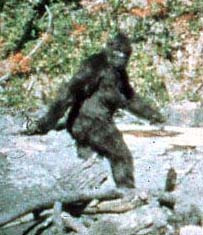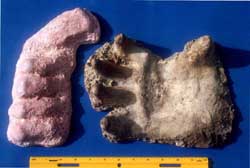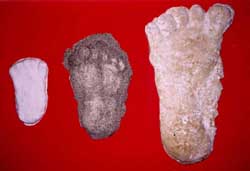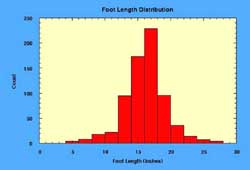|
|

|

FAQ Home > What is a Bigfoot, or Sasquatch?
Anatomy |
 The sasquatch is a large, hairy, bipedal non-human primate (Fig. 1) that is distributed over the North American continent to varying degrees of concentration. Its massiveness, deviation from human bearing and different gait leave no doubt in the mind of observers that they have seen a creature different from man or known animals. The sasquatch is a large, hairy, bipedal non-human primate (Fig. 1) that is distributed over the North American continent to varying degrees of concentration. Its massiveness, deviation from human bearing and different gait leave no doubt in the mind of observers that they have seen a creature different from man or known animals.
Skin
Skin color ranges from the deepest black or charcoal to deep brown, "sunburned" reddish brown, and gray. Some areas, like the nose, appear at times in a shiny, oily black color. The palms are lighter in color, and the soles of the feet quite light, presumably as a result of thick sole pads composed, as in other primates, of fat and connective tissue. A few albinistic sasquatches have been seen, whose skin color was pink.
Hair
The sasquatch is covered with hair, not fur. Fur has guard hairs and an undercoat, while primate hair consists of one type of hair alone. The sasquatch, being a primate, does not molt its hair, but it is replaced one hair at a time, hence is not found in wooly batches.
 Color of the hair ranges from black or dark (50%), through various shades of reddish-brown and gray to white. The body can have varicolored patches of hair. Older animals have increasingly grey hair, though color does not appear to change from childhood to adulthood. Hair is variously glossy clean and shiny, fluffy, or dirty, matted and unkempt ("angora goat dreadlocks"), probably a function of native curliness, age, or of recent immersion in water or lack thereof. Females have been reported to be cleaner than males. Color of the hair ranges from black or dark (50%), through various shades of reddish-brown and gray to white. The body can have varicolored patches of hair. Older animals have increasingly grey hair, though color does not appear to change from childhood to adulthood. Hair is variously glossy clean and shiny, fluffy, or dirty, matted and unkempt ("angora goat dreadlocks"), probably a function of native curliness, age, or of recent immersion in water or lack thereof. Females have been reported to be cleaner than males.
Hair length ranges from 3" to around 2’ (15" longest measured in hand, longer observed in the wild). There is no taper or color banding other than graying with age. Long hair covers the head and, almost invariably, the ears; very short hair on the face; occasional reports of heavy hairiness in male faces ("mustache" and "beard") vs. no facial hair in females; long hair across the top of the shoulders (once described as "bouncing like a cape" ); long hair on the forearms ("like a spaniel"); different orientations of hair on back; breasts in females hair covered (contrary to a mistaken claim in the literature); long hair on buttocks, sometimes overhanging them; groin with enough hair to obscure genitalia; and long hair on the calves (like "bellbottom pants" in a sasquatch observed standing in snow). The hair stood visibly on end in situations where the sasquatch appeared frightened.
Under the microscope (Fig. 2), the average diameter of hair is 65 µm (40-90 µm), these values derived from 15 separately collected samples in four States. The cortex has a uniform reddish tinge plus fine pigment granule distribution, whereas the medulla is absent. Intense efforts at DNA analysis of the hair have been uniformly negative, possibly a function of the lacking medulla. Most human hair (Fig. 3) has a medulla, if only fragmentary, but fine blond hair occasionally looks similar to sasquatch hair. Hence, there is no absolute distinction that can be made. Hair from other forest species, like rodents, carnivores, and ungulates can be differentiated without question.
Odor
About 10-15% of close encounters are connected with an intense, disagreeable stench, comparable to the odor of smegma. Gorillas under conditions of distress exude a gagging, overpowering aroma, the origin of which is the axillary organ, i.e., the armpit with its apocrine sweat glands. The same anatomy probably pertains to the sasquatch.
Many reports refer to uneasiness of man or animals ("being watched") well ahead of any subsequent encounter. A pheromone effect has been suggested, meaning the release of a behavior pattern, "fight or flight", by an airborne molecule. Although this substance might originate from the same anatomical location as the odor, the two are not equivalent and should not be confused.
Head and Neck
The head, though massive by direct comparison to that of man, has been described as "relatively" small for an animal of that size, indicative of a rather small brain. The head develops a sagittal crest in adult males as well as in females, probably bony, which sometimes produces the effect of a person wearing a hooded sweatshirt. Some animals, possibly younger, have a round head. Brain volume is probably close to or slightly above that of the gorilla.
There is a conspicuous brow ridge with a receding forehead, giving the eyes a deep-set look. The face (Fig. 4) is rather flat with prominent cheekbones, a square jaw, and the mouth region is only slightly protuberant. Deep brown eye color predominates, with a "red" component common (probably a bloodshot sclera). A white sasquatch was reported to have blue eyes. Night reflection from eyes varies most commonly between red and yellow and is probably dependent on pupillary size rather than true reflectivity.
The nose is near human in shape, though "pug" or flat, sometimes with forward directed nostrils. The mouth is often reported to be thin-lipped, with yellowish, square teeth with human appearance. When larger canines have been seen, they did not project substantially beyond the plane of the other teeth and would be subject to wear with time. Ears are almost invariably hidden under hair and have been reported to be either rounded or pointed.
Muscles from the back of the head flare out to the shoulders to obscure the neck. A result is that, as in weight lifters, the body is usually turned with the head when a rearward view is desired.
Overall, sasquatches seem to exhibit as much individual diversity in looks as do people, ranging from a typical ape appearance to one described as "an old Indian". The cause may well be the result of the animal not being subject to predation, its young being nurtured and protected into near adulthood, and differences in appearance not being a selective handicap. The same considerations apply to the diversity of coat colors.
Trunk
The trunk is generally carried at a forward angle of about 15° ("hunched over"). This means that the species has not achieved a full upright stance, a difference from human beings, although at times the animals stand up straight. When ultimately a specimen comes to hand, the hip anatomy will be of telling importance to the evolution of an upright stance.
The shoulders are proportionately wider than those of man, measuring about 40% of the height in a sasquatch compared to 25-30% in man. Large sasquatches have been described as having four to five foot wide shoulders. They are barrel-chested, with a large respiratory tidal volume, often commented upon when their stertorous breathing has been heard. The Patterson sasquatch (filmed in the famous 1967 movie), a female slightly below the mean height of the population, has a chest circumference of about 60" (a value calculated from available images). This circumference would be about 65" for the average-sized animal and well above 75" for the largest individuals that have been seen.
 Females have breasts, small and conical near puberty (10-12 years, see data below), rather heavy and pendulous during reproductive years (see Fig. 1) and shrunken in old age. They are hair-covered except for the nipples and areolae. Females have breasts, small and conical near puberty (10-12 years, see data below), rather heavy and pendulous during reproductive years (see Fig. 1) and shrunken in old age. They are hair-covered except for the nipples and areolae.
The arms are massive and might exceed human length somewhat, frequently reported as hanging close to their knees, though accentuated by the slouching stance of the animals. They are particularly hairy along the forearms and end in very large and massive hands (once described as "the size of paddles").
The hand deviates in slight but significant ways from the human model (as derived from hand and knuckle prints, Figs. 5). Fingers are generally shorter, especially the thumb, and the latter is carried "farther toward the wrist" as compared to the position in man.  The hand largely lacks the thenar pad (the mounded muscle at the base of the thumb), a corollary of the lowest opposability found in the higher primates (Fig. 6). The hand is proportionately broader than that of man, palm width in adults measuring up to 8". Both finger and toe nails are deeply colored ("nicotine stained"), presumably a combination of dirt and thick keratin, though fingernails are light colored in some. There are no claws. The hand largely lacks the thenar pad (the mounded muscle at the base of the thumb), a corollary of the lowest opposability found in the higher primates (Fig. 6). The hand is proportionately broader than that of man, palm width in adults measuring up to 8". Both finger and toe nails are deeply colored ("nicotine stained"), presumably a combination of dirt and thick keratin, though fingernails are light colored in some. There are no claws.
Young males have a V-shaped trunk, tapering from a wide chest to a narrower waist, whereas the female trunk has an overall barrel shape. Female hips seem to be broader than those of the male. Either sex rarely has a protruding abdomen (other than during pregnancy in the female). Genitalia in the female are hidden by hair, as are generally those of the male. The massive sexual swelling, observed in some female apes, has not been seen in the sasquatch.
 Legs and Feet Legs and Feet
The legs are massive, especially the thighs, in one case reported to be the diameter of a "garbage can" (about 20"), but even in the (female) Patterson sasquatch about 15" thick. The calves are also unusually muscular, the gastrocnemius (calf) muscle being particularly prominent in rear views of the Patterson sasquatch.
Feet are most amply recorded by way of innumerable measured footprints. They range in recorded length from barely walking infants at 4"-5" (Fig. 7) to known female prints and very large presumptive male footprints (Fig. 8). The mean length of 702 prints (collected over nearly 50 years) is 15.6" (Fig. 9) with a range of 4" to 27", and a mean width of about 0.45 times that of the length. This proportion remains about the same with increasing length of the feet. Feet grow in excess of gain in height of the animals to compensate for the exponential increase in weight with linear dimensions.  The foot does not have an arch, but retains the primitive primate midsole flexure of apes, called a metatarsal hinge. During running, often only the anterior half of the foot (anterior to the metatarsal hinge) contacts the ground (Fig. 10). The toes are capable of substantial splaying in slippery terrain, especially abduction of the big toe. The sole is very thick and indents deeply over uneven terrain without harm to the animal (Fig. 11). The foot does not have an arch, but retains the primitive primate midsole flexure of apes, called a metatarsal hinge. During running, often only the anterior half of the foot (anterior to the metatarsal hinge) contacts the ground (Fig. 10). The toes are capable of substantial splaying in slippery terrain, especially abduction of the big toe. The sole is very thick and indents deeply over uneven terrain without harm to the animal (Fig. 11).
Body Size and Weight
The height average for the sampled population is 7’ 10", derived from a combination of eye witness estimates and scaling from footprints. Babies shortly after birth are small (and "ugly", as one eye witness commented) by human standards, but grow rapidly and evidently walk at an early age. Aside from infants being carried, small walking sasquatches, 3-4’ tall, have been seen. The animals reach maturity at a height of 6’-7’ and the largest, reliably estimated individuals exceed 10’. Males are taller than females, but seemingly by no more than about a foot at the median of the population.
Weight is difficult to estimate on sight and seems to vary from animal to animal as much as in people, but a tight, established relationship exists in primates between chest circumference and weight. Applying this formula, the average sasquatch can be estimated to weigh 650 lbs (Fig. 12), the Patterson sasquatch 540 lbs, and the maximum (for a 24" or larger footprint) probably to exceed 1,000 lbs. | | Next: Physiology |
| |
|
|

























